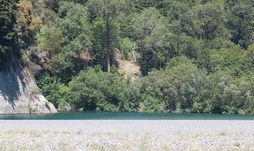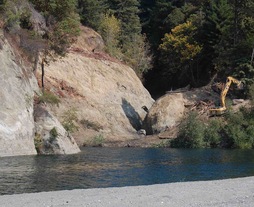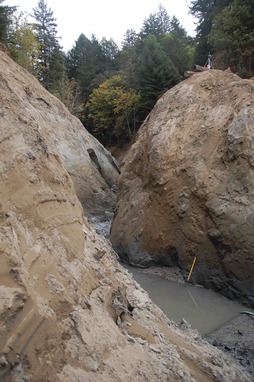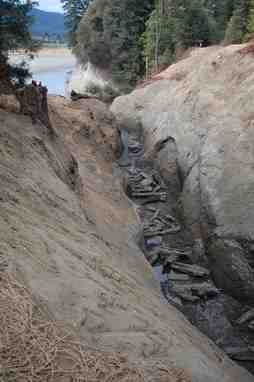Eel River Fish Passage Project at Bridge Creek

BEFORE: For many decades, the North Western Pacific Railroad crossing, which long ago erected a 45 foot high earthen dam and culvert system, blocked fish from migrating into Bridge Creek. © CalTrout

AFTER: A unique geologic feature at the creek-river confluence is exhumed after lying buried under railroad fill for decades. © CalTrout

AFTER: Sandstone cliffs, mirroring those at the Holmes pool carved by the Eel River, rise high along the lower reaches of Bridge Creek. © CalTrout

AFTER: Large wood logs and boulders are placed back on the streambed to armor the bed, along with extensive erosion control measures to minimize winter erosion. © CalTrout
CalTrout and Partners Remove Barrier at Bridge Creek
Along the mainstem of the Eel River about 35 miles from the Pacific Ocean, Bridge Creek drains its watershed into the famous Holmes Hole, a gigantic pool guarded by towering sandstone walls, and deep water that annually provides safe haven for thousands of adult salmon and steelhead on their way up river to their natal spawning grounds.
For many decades those fish have been blocked from migrating into Bridge Creek by the North Western Pacific Railroad crossing, which long ago erected a 45 foot high earthen dam and culvert system through which no adult fish could ever pass.
Now this barrier is gone.
And, not only is Bridge Creek able to flow freely to the Eel River once again, but the project has revealed a rather unique geologic feature at the creek-river confluence, exhumed after lying buried under railroad fill for decades. Sandstone cliffs, mirroring those at the Holmes pool carved by the Eel River, also rise high along the lower reaches of Bridge Creek. Incredibly, these cliffs were buried by the construction of the railroad, and no one could remember what lay hidden under the mound of dirt.
CalTrout and our Partners have completed the construction phase of the Bridge Creek Fish Passage Project. Following several years spent lining up funding and support from the North Coast Rail Authority (NCRA), and another year finalizing construction plans, the project was launched into construction early this summer. Project funding comes from the CDFW Fisheries Restoration Grants Program and the State Coastal Conservancy, with a small share of costs and tons of determination from our project partners. In addition to our funders, the Bridge Creek project has received unanimous support from the NCRA board, and engineering oversight from the NCRA and NMFS engineers. From start to finish, the project has been in the capable hands of Pacific Watershed Associates (PWA) and our construction contractor Ryan Rice Construction.
Many technical aspects challenge a project of this scale, such as deconstructing and stockpiling railroad tracks and wooden ties, re-routing the creek and diverting dirty water away from the Eel, and removing trees and vegetation. But the biggest task for this project was simply moving dirt, tons of it. Excavators and dump trucks toiled for more than eleven weeks, removing layers of fill foot-by-foot. In total, we’ve removed more than 55,000 yards of dirt and stockpiled it safely along the railroad line. That’s a mere 2,750 truck-loads (more or less) with the gigantic 20-yard off-road dump truck we used. With the dirt-moving complete, construction crews worked to re-create a natural Bridge Creek stream channel and banks, and a new confluence with the Eel River. Large wood logs and boulders will be placed back on the streambed to armor the bed, along with extensive erosion control measures to minimize winter erosion.
Now we wait for the fish to arrive.
We would like to acknowledge the invaluable support from private landowners, Jack Rice and his family, as well as the Humboldt Redwood Company, for their willingness to allow this project on their properties.
Learn more about Eel River Restoration.